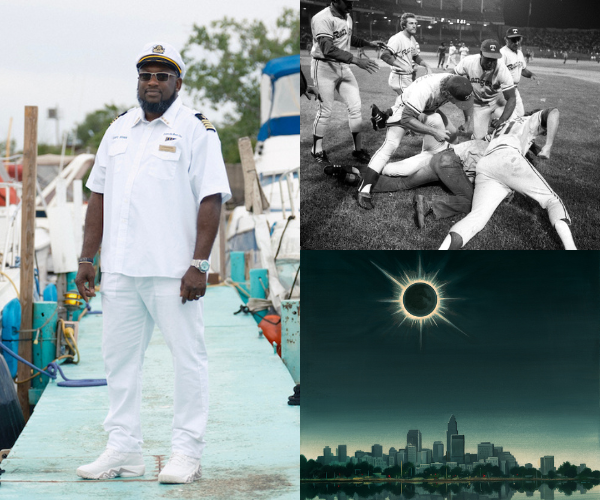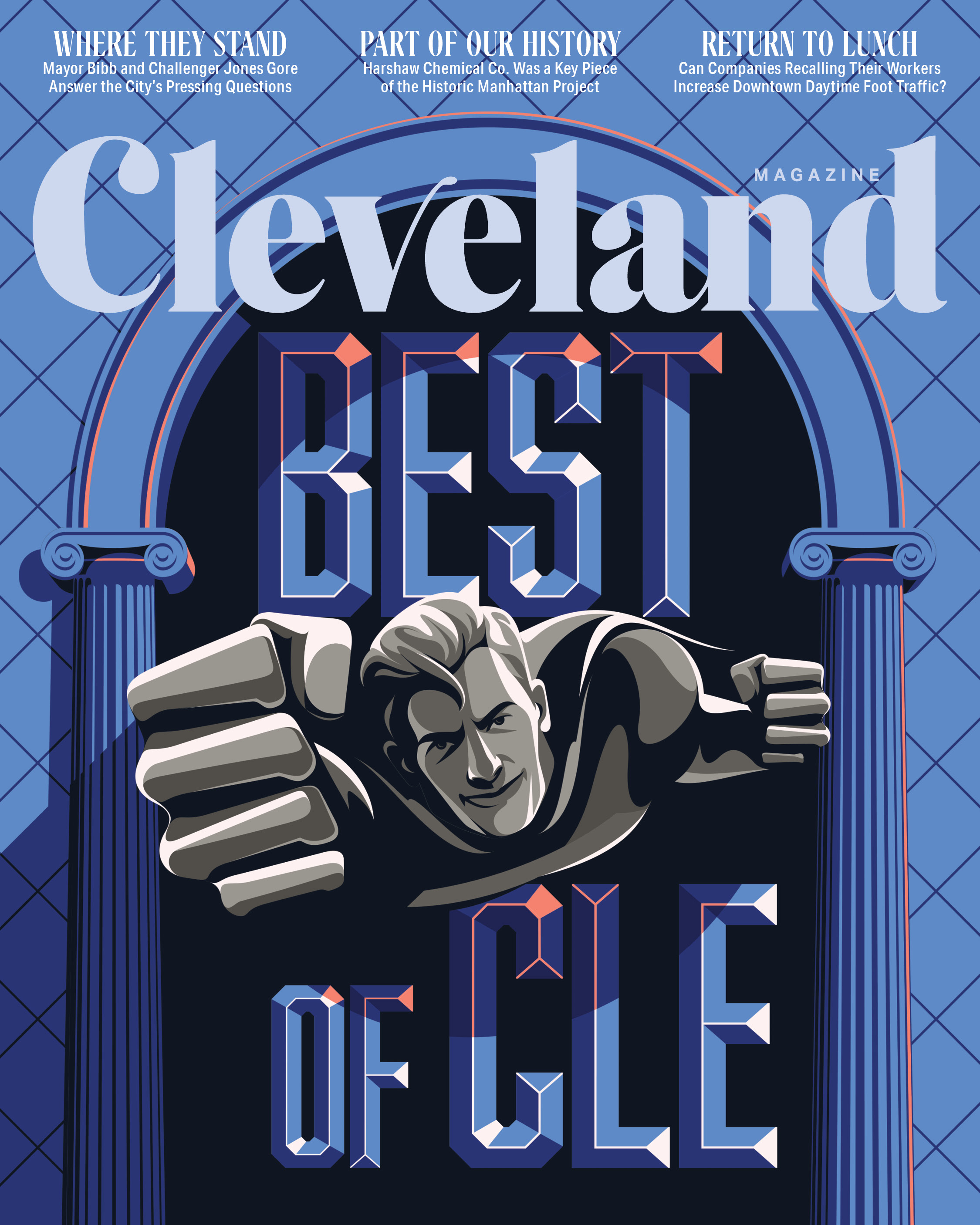Can Cleveland Find an Activist Spark?
by Sheehan Hannan | Dec. 6, 2016 | 2:00 PM

Aaron Marcovy rounds a curve and cuts the boat’s engine as he approaches the Carter Road Bridge. The executive director of the Foundry rowing center guides the vessel’s shallow hull through the no-wake zone. He and his coaches regularly shepherd rowing teams from St. Joseph Academy and St. Edward High School along this stretch.
On the right, a white boat is moored beside the bulkhead, surrounded by floating paper scraps and soda cans. Opposite, a pair of kayakers glides silently past. Trash inevitably finds its way here, he says, driven into the water by heavy rains.
“I’ve seen this river evolve over the last 25 years, and I would say that it’s cleaner,” says Marcovy.
We glide past the brick bulwark of Fire Station 21 where the Anthony J. Celebrezze fireboat is docked. In 1969 the Celebrezze quelled a blaze from an oil slick on the water outside the Republic Steel plant. While it lasted only 20 minutes, the fire charred Cleveland for decades as a polluted city, a place where even the water was flammable.
While Carl Stokes was wary of organized environmentalism, the dynamic black mayor was left to clean up the mess.
He even skipped the city’s first Earth Day in 1970, according to David and Richard Stradling’s 2015 book Where the River Burned.
Stokes had a knack for intertwining Cleveland’s ills with a message of accountability and cleanup. But he only did so after voters demanded action. That arrived in the form of an April 1970 letter-writing campaign and a banner hung from the West 25th Street bridge over Interstate 71 that read, “Welcome to the fifth dirtiest city.” The burning river lit a flame under a burgeoning movement.
By eradicating rats in Hough, creating a chlorinated pool in the lake at Edgewater Beach and regulating air pollution, Stokes put forth an agenda that used environmentalism as a tool to solve Cleveland’s longstanding problems — racial segregation, poverty and middling city services.
In the burning river, Cleveland’s mayor and its citizens found a symbol to spur substantive change that eventually led to the Clean Water Act in 1972. But that blaze was quelled long ago.
“The river is in the best place it’s ever been since humans came,” says Jane Goodman, executive director of Cuyahoga River Restoration. The walleye population is returning to the industrial channel, she says. They’re even safe to eat on occasion.
The Foundry is fostering a culture of competitive rowing. There’s a water taxi once again. Walkers and joggers regularly tread the Towpath Trail. What was once the symbol of our environmental failures stands as a beacon of recovery.
Yet Stokes-era environmental problems persist. Thousands are living in homes poisoned by lead. Some Cleveland neighborhoods have infant mortality rates comparable to developing nations. In a March study by the Brookings Institution, Cleveland ranked ninth of 100 large U.S. cities for concentrated poverty. A child born in Cleveland has a 50-50 chance of living in an impoverished household. And a study by the Economic Innovation Group netted Cleveland the dubious honor of being the most distressed big city in the country.
Yet with no tangible symbol, few voters are prodding their elected representatives to address those problems, as in the Stokes era.
For a moment, it seemed the 2014 shooting death of 12-year-old Tamir Rice might be such a catalyzing event. Rice’s death was an earth-rattling shock and got straight to Cleveland’s original sin — our physical and psychic racial divide.
While it raised legitimate questions about biased policing, the killing of a black boy by a white officer should have also drawn more attention to other ills that disproportionately affect Cleveland’s poor and minority communities. The attention and activism that followed could have easily included issues of inequality in the way Stokes used the river fire to make communitywide change.
Instead, the subsequent uproar, framed narrowly as a matter of legality and police reform, seemed to be exhausted with the ouster of county prosecutor Tim McGinty. Headlines shifted to brighter things — a championship, a political convention and the World Series.
Two years after Rice’s death, Cleveland’s signposts point toward revival. But that same city remains in the throes of an environmental and civic crisis that takes its hardest toll on poor or majority-black neighborhoods.
There is the city’s ongoing lead poisoning problem, made worse by a health department that performed so poorly it lost federal lead remediation funds in 2012. In some Cleveland and East Cleveland neighborhoods, in fact, between one-third and half of children are probably exposed to lead, according to The Plain Dealer’s 2015 investigation.
There is Cleveland’s polluted air. The American Lung Association’s 2016 State of the Air report ranked Cleveland 11th worst of 171 cities in its measurement of annual particle pollutants. And a May American Thoracic Society report ranked Cleveland the ninth worst city in the country for both ozone and particulate matter. The study estimated that pollutants contributed to 196 deaths and 487 instances of illness in Northeast Ohio between 2011 and 2013.
There is the city’s infant mortality problem, which stands at twice the national average over the past five years. Yet county and city leaders are just now teaming up to address the problem with a $3 million initiative offering prenatal care and home visits.
There is also our outdated infrastructure, built with no mind for the environment.
Back on the boat, Marcovy guns the engine under the Hope Memorial Bridge. He points out a figment of revival — a pier from the Towpath. “I see runners and fishermen out there all the time,” says Marcovy.
A stone’s throw upriver is a yawning concrete tunnel that opens to the water, one of the Northeast Ohio Regional Sewer District’s 124 combined sewer overflows. Marcovy pulls up. It’s dry, but you can feel the draft. “Can you smell it? Did you get cold?” he asks. “That’s it, in all its glory.”
Cleveland’s sewer system, as it was originally constructed, simply dumped raw sewage and rainwater directly into the river. But since the passage of the Clean Water Act in 1972, reinforced with a federal consent decree in 2010, the Northeast Ohio Regional Sewer district has constructed a series of massive retention tunnels to keep such untreated waste from getting dumped into waterways.
But an occasional high-volume downpour can overwhelm the system. And despite progress, fixing it is a 25-year, $3 billion battle.
We have made efforts. Mayor Frank Jackson’s Sustainable Cleveland 2019 initiative convenes corporations, nonprofits and public thinkers to talk about issues from air quality to public transit each year. But today’s problems are ingrained and difficult to grasp in a daylong lecture or workshop.
They’re even harder to fix when there is no loud, organized coalition willing to step up.
But that is no revelation. We’ve been here before. In 1964, water pollution activist David Blaushild took out ads in The Plain Dealer and Cleveland Press.
“Lake Erie is dying,” Blaushild wrote. “Does anybody care?”
Nobody did, until the Cuyahoga burned.
What will be the spark that makes us care again?
Trending
-
1
-
2
-
3
-
4
-
5










